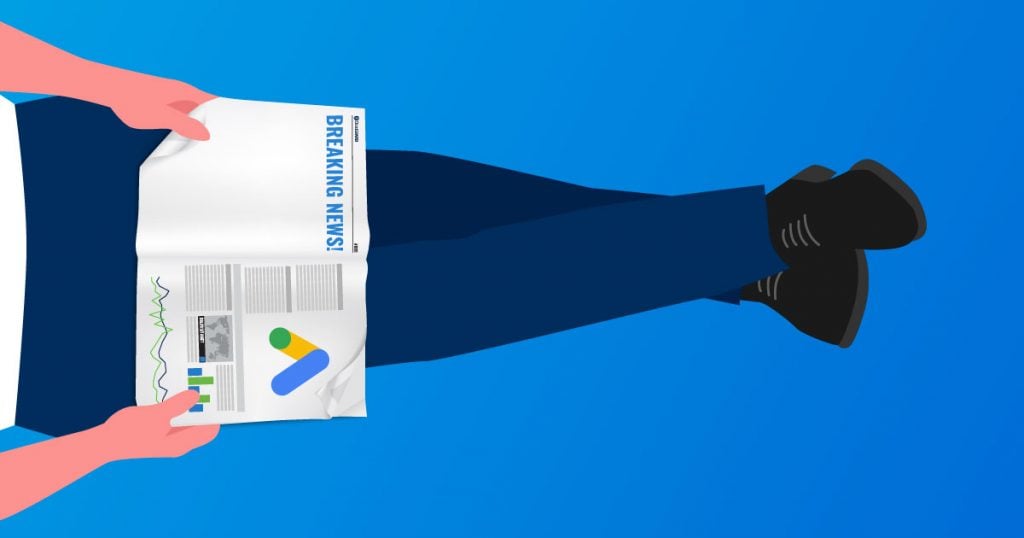The truth is that the best PPC ad network depends on your business requirements, as there are a variety of options. Given the popularity of PPC (Pay-Per-Click) ad networks, it’s no surprise many routes have become available to modern marketers over the last few years. While Google Ads remain at the forefront of the PPC industry, it’s always worth considering and learning about other options for your business.
Today we investigate the various PPC network options available to you alongside the benefits of using each. At the end of this article, you should be able to answer the question: “what is the best PPC ad network for my business?”
What are PPC Ad Networks?
Before we get into the list of the best PPC ad network options for your business, we must understand the definition of an ad network.
Ad networks are platforms that link ad publishers with advertisers. Ad publishers refer to individuals or companies who want to sell ad space on their website because they own a digital content property with an audience. Publishers effectively offer up some of the space in that content property to external ads.
These ads come from advertisers; any individual or company who wants to promote a product or service. However, it would take considerable time for these advertisers to contact hundreds of ad publishers, and so they take advantage of the power of a PPC ad network to do it for them.
Advertisers get to use a single space – the PPC ad network – to pay for ads, which this ad network then distributes across the internet where available, and more importantly, where applicable. A massive part of what the ad networks handle for the advertisers is placing the ads in the digital spaces where the audience of said advertisers is more likely to be present.
One of the main differences between ad networks and other advertising methods that make use of publishers – such as affiliate marketing or sponsored posts – is that they provide a much more automated and hands-off marketing option.
Think of the ad network as the intermediary between the publishers and the advertisers. You can also expect to find a range of useful tools on these platforms. You can expect tools for keyword research, ad creation, budget management, budget optimization, and a range of analytics for your different campaigns.
How Does the PPC Ad Network Process Work?
Ad networks do not work the same for advertisers and publishers. Advertisers create ad campaigns and decide how you want to bid on keywords and phrases. Based on your bidding structure you will then pay a fee every time someone clicks through one of your ads to your platform. The most common bidding structures include:
- Pay Per Click, shown as CPC (Cost Per Click).
- Pay Per Thousand Impressions, shown as CPM (Cost Per Mile).
- Pay Per Acquisition, shown as CPA (Cost Per Acquisition).
While these bidding strategies are the most popular, some platforms such as Google or Meta (Formerly Facebook) have a more diverse selection of options for further customization.
However, if you are a publisher, you will need to join the network through a review process. You must pass this review process before you can start selling ad space on your digital platform. Once you pass the review, you can place ads on your website in a variety of ways. The most common include a code snippet that handles the ad cycling for you, or receiving bids from advertisers and then deciding which ads you want to display.
What are the Different Types of Ad Networks?
As there are advertising network providers, there are also different types of advertising networks. These different types of ad networks include:
Vertical Networks
Vertical networks specialize in advertising for highly specific audiences. These networks often only advertise in one industry or niche. This niche approach means that you are less likely to find a vertical network that can assist with general advertising.
Premium Networks
Premium networks work specifically with high-traffic websites from top-tier publishers and creators. These networks are naturally more expensive, but given the publishers they provide access to, you can expect a large number of eyes on your advertisements.
Inventory-Specific Networks
Inventory-specific networks operate similarly to vertical networks in that they have a niche. The main difference is that where the niches of vertical networks are for a specific industry or product type, the niches of inventory-specific networks are for a content type that hosts the ads. An example of an inventory-specific network would be one that only places ads on mobile apps or music streaming services.
Targeted Networks
Targeted networks utilize incredibly specific criteria for ad placement, making it a good choice for advertisers who prefer not to cast a wider net. The criteria that targeted networks focus on for ad placement can include a variety of consumer traits from location to user behaviour to demographics.
Performance and Affiliate PPC Ad Networks
Performance and affiliate PPC ad networks focus on the actions of users rather than simply displaying ads in specific places. You will pay these networks based on specific criteria such as users signing up, making purchases, or simply clicking through to your website.
What are the Different Types of PPC Platforms?
There are different types of pay-per-click advertising sites. It is not atypical for a platform to offer more than one of these PPC advertising types, which include:
Search
A Search PPC ad network commonly helps advertisers create campaigns that target searches for relevant keywords or phrases on search engines. Through these ad networks, you can typically identify and bid on keywords relevant to your services or products and even track the performance of these keywords or phrases.
Businesses that want to drive more qualified traffic and potentially increase conversions often utilize Search PPC ad networks. An example of a Search PPC ad would be a Google Search campaign, which allows you to target customers searching for specific terms such as “computer parts” or “family restaurants”.
Display
Display PPC ad networks provide digital ads that can appear at the top, on the side, or in the middle of viewed web content. These networks help you increase your brand awareness and engagement by targeting users who need to actively search for your products or services. These ads are often displayed to a wider audience to increase reach.
An example of Display PPC ads would be Google Display Network (GDN). This service allows advertisers to create ads that GDN then displays to a specific demographic or previous customers.
Social Media
Social media PPC networks use social media platforms like Facebook and Instagram for a variety of purposes. These purposes range from increasing brand awareness to building a new audience and even engaging with potential customers. Based on your business requirements, you can tailor your campaigns to focus on specific demographics, locations, customer interests, and more.
Facebook Ads is an example of a social media PPC network that provides advertisers with the ability to create highly targeted campaigns that use data like age, gender, location, and even general interests. Additionally, these tools often come with insights and data analytics to help you improve future ads or iterate better on existing campaigns.
As you navigate the dynamic landscape of pay-per-click advertising, safeguarding your campaigns against potential threats is paramount. ClickGUARD™ emerges as the ultimate shield, ensuring your ad networks remain resilient in the face of click fraud.
The 9 Best PPC Ad Networks for Marketers
As mentioned, there are several PPC networks available to advertisers and depending on their business requirements, some will work better than others. However, in terms of general capabilities and overall scores, we have put together a list of the 9 best PPC ad network options, starting with the biggest of them all, Google.
Google Ads
There is no denying the sheer presence of Google, which makes it no surprise that they own by far the largest share of PPC advertising networks – sitting at a massive 73% of the global market share. Google sees more than 100,000 searches every second, more than eight billion every day, and more than 2 trillion every year. No other search engine comes close to this amount of traffic.
Given the size of Google, it’s only natural that Google Ads provides the largest PPC ad network available. However, even those looking for free tools will find some value from Google Analytics and Keyword Planner. Additionally, Google Display Network is the industry’s leading display PPC ads platform available to a variety of websites like YouTube, Blogger, and more.
Advertisers should note that due to its popularity, PPC ads on Google can prove expensive, especially for keywords with excessive competition.
Benefits of Google Ads Network
- By far the biggest global reach given their sheer number of daily users.
- Google Ads offer many different bidding strategies that assist with:
- Conversions
- Clicks
- Visibility
- Interactions
- Large number of free and paid tools to help you optimize your PPC campaigns.
- Largest number of website selections for Display PPC ads.
- Extensive analytics and reporting for better campaign iteration.
- Customization options for a variety of customer targeting methods.
Microsoft Advertising (Bing Ads)
Next up we have the second largest PPC network with Microsoft Advertising. Microsoft will come up in every list that contains the biggest names in tech, so it’s no surprise they placing as the second largest PPC network.
Bing – and consequently Microsoft Advertising – does not have the reach of Google Ads, but for those seeking cheaper alternatives it might be a clear winner. Similar to Google, Microsoft Advertising has a selection of bidding strategies and tools like paid search engine results or display PPC options. Microsoft also has a good selection of websites for those who want to display banners, videos, or content ads. These platforms include Yahoo!, AOL, and even MSN.
Microsoft has a fairly busy search engine coming in at just over five billion searches per month on the platform, which is no small feat. Microsoft also owns about 36% of the market share in the USA, 20% of the market share in the UK, and one-third of the total global market share.
Benefits of Microsoft Advertising (Bing Ads)
- Massive amounts of traffic even though they are second in comparison to Google.
- Has a sizable market share in the USA and UK, making it a good option for advertisers marketing in those regions.
- Less competition for PPC ads on the network naturally makes most options more affordable than Google.
- Good number of website options for display banners, videos, and content ads.
- Microsoft’s PPC ad network tends to have users from high-earning backgrounds.
- Automated bidding strategies available.
- Cross-channel exposure for your ads given Microsoft’s collaboration with Roku.
Meta Ads (Facebook Ads)
In third place is another tech giant that many might still refer to by its old name, Facebook. Meta Ads provide businesses with a different – albeit still good – ad network. Meta does away with the emphasis on searches and focuses much more on demographic targeting.
Meta Ads do not rely on your customers actively searching for your products. Meta instead matches ads up to customers based on a variety of aspects from interests to demographics and even location. These ad matches occur on two of the world’s biggest social media platforms, namely Meta (Facebook) and Instagram.
You can also make your ads available on Facebook Messenger or the Facebook Audience Network. These options make Meta Ads a solid option for businesses who want to advertise within the mobile application space.
Benefits of Meta Ads (Facebook Ads)
- Top-tier choice for businesses that want to utilize demographic-specific targeting.
- Native content ads can prove more effective at times since customers do not have to search for your products first.
- Ideal place for businesses who prefer to create visual ad campaigns.
- You are not required to bid on keywords since the algorithms handle who sees your ads.
- Businesses who prefer to advertise within apps can thrive here.
- Cheaper PPC ad network than Google or Microsoft.
Taboola Ads
Taboola operates similarly to Google AdSense and Google Display Network but works with a carefully curated list of websites. Advertisers pay to have their ads displayed on Taboola’s partner sites – specifically news websites.
Taboola can help place your ads on massive websites like Business Insider, CNBC, NBC News, Fox News, AOL, and MSN – often at more affordable prices than other options on the list. Those who wish to advertise here must make engaging content that can draw readers of the news sites to their own products, so it requires some finesse. You have options for either CPM or CPC Pay-Per-Click bids.
All the websites on Taboola’s partner list have more than a million visitors per month. Compared to Google AdSense – where publisher websites can have any amount of traffic – Taboola offers a greater possibility for more eyes on your campaign.
Benefits of Taboola Ads
- Ideal for all forms of content marketing.
- Much lower CPC compared to other PPC ad networks.
- Only partnered with high-quality websites that have more than a million monthly visitors.
- Good place to retarget people who previously engaged with your campaigns.
- You have control to prevent your content from appearing on certain partnered websites or certain news topics.
LinkedIn Ads
Touted as the world’s largest professional network, LinkedIn offers a PPC ad network allowing you to reach a learned marketplace with reliable purchasing power. LinkedIn Ads allow you to target specific demographics – although unlike Facebook these demographics are more likely marketers, C-level executives, and business owners.
Given the user base, LinkedIn Ads is a good place for B2B ads, especially if your business wants to further customize how your ads appear. You can utilize sponsored posts, InMail (direct mailing to specific audiences), text ads, dynamic ads, and a display partner network.
You can expect a minimum bid of around $2 for CPC and CPM advertisements, while they offer a Cost-Per-Send model for InMail ads.
Benefits of LinkedIn Ads
- The quality of the audience is often hard to beat, especially if you have a B2B company.
- You have options for native and non-native ads.
- You have options for direct mail marketing.
- You can customize your marketing to target specific demographics across detailed verticals like industry, job title, size of company, and more.
- LinkedIn Ads provides access to lead generation forms which makes it simpler to manage your leads.
X Ads (Formerly Know as Twitter)
Another social media giant providing a solid platform for businesses seeking PPC options for straightforward marketing. With close to half a billion active users worldwide, X offers a good ad network for a variety of industries.
Your X ads will appear in the feeds of users, so they look similar to ordinary tweets. You can also opt to have ads appear in the ‘Who to Follow’ sections of search results if you want to promote a business account instead.
Given that X users are primarily accessing the platform on mobile, it’s a solid choice for businesses who want to meet their clients in an app.
Benefits of X Ads
- Variety of ad options include text, image, video, carousel, live, or moment ads.
- Decent CPC averaging at around $0.33.
- Access to a wide variety of audiences worldwide.
- Customers can interact with your ads and comment on them, or even retweet them.
- Excellent place to show off the personality of your business.
Amazon Publisher Services
Ideal for digital business, Amazon Publisher Services offers a range of PPC ad options. The big differentiating factor here compared to other options on the list is Amazon’s shopper data. This data allows you to place ads in front of customers based on shopping profile demographics in addition to typical options.
Ads can appear in a variety of places ranging from Amazon’s home page to displays that pop up in-search. Amazon also owns Twitch – one of the largest streaming platforms in the world – so your ads can naturally appear there as well.
Your ads can also take on various forms like product display ads, sponsored product ads, or video ads.
Benefits of Amazon Publisher Services
- Access to demographics centre more around shopper profiles.
- Excellent choice for reaching customers on mobile given the amount of people who shop on Amazon using mobile devices.
- Access to Twitch advertising which allows you to utilize channels with massive amounts of daily viewers.
Reddit Ads
With an estimated 1.5 – 1.6 billion visits in 2022 and around 15 minutes of average time spent on the platform with each visit, Reddit offers a good place to reach audiences outside of Meta, X, or Instagram.
Reddit offers three main types of ads including promoted posts, videos, and carousel ads. In addition, you can show Reddit ads to mobile users, making it a good option for desktop and mobile advertising. You can expect a fairly low CPC at around $0.44 per click.
Reddit houses several ‘subreddits’ which are essentially individual forums dedicated to specific topics, which makes it possible to target audiences based on their interests.
Benefits of Reddit Ads
- Fairly large social media platform with a massive number of active users.
- Offers a competitive CPC at around $0.44 per click.
- You can narrow down your content to specific demographics such as user interests.
Outbrain Ads
Outbrain is similar to Taboola in that it is also focused on content marketing on partnered websites. Outbrain includes a massive number of partner websites like CNN, The Washington Post, WSJ, The Guardian, and MSN.
In addition to Outbrain’s good list of publisher websites, you can expect a reportedly low CPC of around $0.10 which is fantastic.
Benefits of Outbrain
- Offers a wide range of over 100,000 publisher websites.
- Lower CPC than most competitors.
- Offers dynamic retargeting that allows you to show users products or services they previously showed interest in.
Maximize the Value of Any PPC Campaign With ClickGUARD™
With so many businesses utilizing the power of pay-per-click advertising sites, it’s easy to forget the importance of making sure you maximize your value. Whichever of the nine best PPC ad network options you prefer to go with, it’s important to secure your ads against click fraud.
Click fraud can skew your metrics and increase the prices of your CPCs even though the clicks are not coming from real people.
When you use ClickGUARD™, you can expect a powerful click fraud prevention tool that helps you protect your business CPCs so you can reach intended targets with increased efficacy. Start your free ClickGUARD™ trial today and integrate leading click fraud protection into your campaigns.



